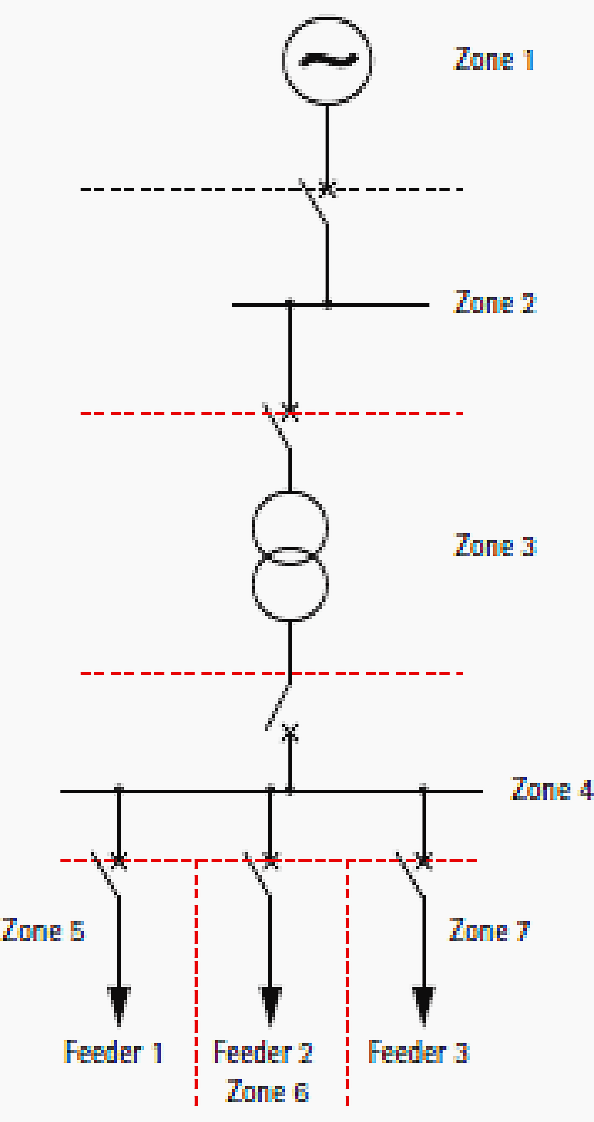The quality of protection
The basic function of electrical protection is to detect system faults and to clear them as soon as possible. For any one particular application, there are many ways to do this function, with varying degrees of effectiveness. The choice is influenced by the overall protection philosophy of the plant, and the importance of the equipment or portion of the network to be protected, weighing cost against performance.

The general philosophy of applying protection in a power network is to divide the network into protective zones, such that the power system can be adequately protected with the minimum part of the network being disconnected during fault conditions.
The zones can either be very clearly defined, with the protection operating exclusively for that zone only as in differential protection, illustrated in Figure 1.

The zones can be less clearly defined, with overlapping of the protection function between zones for example, overcurrent protection, as illustrated in Figure 2.

Numerical Relays
The distinction between digital and numerical relay rests on points of fine technical detail, and is rarely found in areas other than Protection. They can be viewed as natural developments of digital relays as a result of advances in technology. Typically, they use a specialized digital signal processor (DSP) as the computational hardware, together with the associated software tools.
The input analogue signals are converted into a digital representation and processed according to the appropriate mathematical algorithm. Processing is carried out using a specialized microprocessor that is optimized for signal processing applications, known as a digital signal processor or DSP for short.
By using multiple microprocessors to provide the necessary computational performance, a large number of functions previously implemented in separate items of hardware can now be included within a single item.
Case Study: Baleela Oil-Field Network
In power systems, the analysis of the network is an important step to determine the performance, both under normal operation and during faults conditions. Fault levels at different parts of the network, as well as protection coordination are some of the many important parameters that define the performance of the network.
Site Overview
A site visit was conducted to Baleela Oil-Field network in order to collect the data of the existing network, collect the uploaded settings of the protection system and investigate the defects of the existing settings.
The following data was collected:
- Details of 33kV and 11kV substations in the network.
- Single line diagram of the Baleela Power system network.
- Impedances of all transmission lines and transformers.
- Reactance and MW rating of all generators connected to the network.
- Load details (MVAr and MW) of the existing network.
- Length and type of transmission lines from one substation to another.
The collected data old settings is shown in appendix A and B respectivly.
| Title: | Overcurrent protection study for a power network (solving the relay setting miss-coordination) – Ahmed Hatim Abdelbari Elniema, Ahmed Omer Mohamed Babiker And Mohamed Ali Mohamed Ibrahim at Faculty of Engineering Department of Electrical and Electronics Engineering, University Of Khartoum |
| Format: | |
| Size: | 2.9 MB |
| Pages: | 132 |
| Download: | Here 🔗 (Get Premium Membership) | Video Courses | Download Updates |
Further Study – How to design Bay Control Unit (BCU) in a substation automation system
How to design Bay Control Unit (BCU) in a substation automation system


What causes over current to the power system and what might be the solution to it.
When we start II nd Generator frequency and Generating voltage should be match with first Generator at that time IInd will be synchronize with Ist Generator then load will be shift at that time slightly Voltage and frequency will be down but then Ist Generator will be pick up the IInd Generator and load will be distribute .
Kindly I need your help how to synchronize two generators depending on load demand.
There are several equipment to do this job and depends on your budget. It, though, would be helpful to let us have an idea on the budget. In general words there are modules that are in command of power management and can be set on how to respond, load depending start stop, auto synchro, auto connect, auto discconect etc.
HI
Thanks for memebering.
pls sir i need help for how to connet five three phase generator one load automatic
Hi,
Does EEP take submittals of thesis to publish on the website?
Sure, if the thesis is in our field of interest.